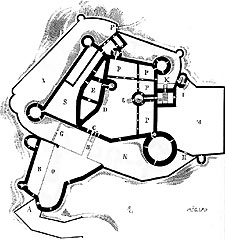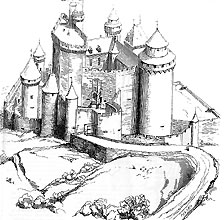|
Description of the castle
This transition is
extremely interesting to study, and though we had few castles which
were built of only one jet during the reign of Charles VII, it is
however that we will give here, as well because of its state of
conservation as because its system of defense is followed with method
in all its parts: it is the castle of Bonaguil.
Located A a few kilometers of Villeneuve-in Agen, this castle is
built on a headland which orders a procession. Its plate is that
of all the castles of mountain; surround by escarpments, it is accessible
only on one side. Here is the plan:
 In
A is the first entry, provided with a drawbridge and opening in
a work advances, kind of weephole or boulevard into 0. It is seen
here already that the manufacturers endeavoured to flank this first
defense. In R were stables probably. A broad ditch cut in the rock
separates the work advanced from the castle, in which one penetrates
by a second drawbridge B with door and postern C a keep E, of odd
form, orders the outside. The advanced work 0 and ditches. In
A is the first entry, provided with a drawbridge and opening in
a work advances, kind of weephole or boulevard into 0. It is seen
here already that the manufacturers endeavoured to flank this first
defense. In R were stables probably. A broad ditch cut in the rock
separates the work advanced from the castle, in which one penetrates
by a second drawbridge B with door and postern C a keep E, of odd
form, orders the outside. The advanced work 0 and ditches.
Out of P are high the apartment buildings at which one arrives by
a beautiful spiral staircase J D is the slope which goes up to the
elevated door of the keep E In S is a separate work of the castle
by the keep. As in Pierrefonds, the keep establishes a separation
between two courses. The raised drawbridges, one could be introduced
into the castle only by crossing the postern F bored in the external
wall of counterguard, while following the bottom of pit N, by crossing
one second door G bored in a cross-piece, a third door H giving
on a beautiful platform M, by taking staircase I, and passing by
a small drawbridge K.
There one found beautiful and broad staircase with stages communicating
to the staircase J interior only by one narrow and sinks corridor
on which, on the right and on the left, loopholes open. The large
staircase goes up only to the ground floor, elevated of the interior
court; its cage finishes at its top by a gross square tower in communication
with the apartments. It is seen that here, as in the old feudal
castles, all the most meticulous precautions were taken to mask
the entries and to return them of a difficult access. By the fact,
there is only one entry, that A B, the turnings which we have just
described being able to be practised only by the familiar ones of
the castle and to make exits when need was. But from the provisions,
all news then, come to modify the old defensive system; initially
the advanced work 0 with the platform M give the projecting considerable
ones, which beats the outside with far, and flank the castle on
the side where it is accessible from appartment; then with the short-nap
cloth of the contrescarpe of the ditches, on the level of the peak
of the walls of counterguard, of the embrasures for gun are bored
at ground floor in the courtines and the lower stages of the turns;
the turns are hardly engaged, for better flanking the courtines.
If one judges some by the opening of the doors which give entered
the turns, the parts put thus out of battery at ground floor could
not be of a large gauge. As for crownings, they are provided with
projecting covered ways with machicolation and crenels; but the
consoles carrying the parapets of the cylindrical gross tower are
not any more simple corbels of 0,30 C at 0,40 C thickness; they
are large corbellings, pyramids posed on the point, which resisted
the ball better that the supports of the first machicolations. Let
us merlons parapets are bored loopholes which obviously indicate,
by their provision, the use of weapons has fire of hands.
 Here
a riding sight of this castle, catch on the side of the entry. One
sees, in this figure, that the embrasures intended for artillery
with fire are bored in the lower stages of constructions, and follow
the declivity of the ground, so as to shave the neighbourhoods.
For crownings of the turns, the method adopted in XIVe century is
still followed. The transition is thus obvious here, and the problem
which the military architects sought to solve in the construction
of the fortified towns about the middle of XVe century could be
summarized by this formula: "To beat the outside with far,
to defend the approaches by a shaving shooting of pieces of ordnance,
and to guarantee themselves against the climbing by a command very
é1evé, crowned according to the old system for brought
closer defense" the keep, covered in terrace and strongly arched,
was also made to receive gun at its top, which was justified besides
by the accesses which, on a side order the castle. Here
a riding sight of this castle, catch on the side of the entry. One
sees, in this figure, that the embrasures intended for artillery
with fire are bored in the lower stages of constructions, and follow
the declivity of the ground, so as to shave the neighbourhoods.
For crownings of the turns, the method adopted in XIVe century is
still followed. The transition is thus obvious here, and the problem
which the military architects sought to solve in the construction
of the fortified towns about the middle of XVe century could be
summarized by this formula: "To beat the outside with far,
to defend the approaches by a shaving shooting of pieces of ordnance,
and to guarantee themselves against the climbing by a command very
é1evé, crowned according to the old system for brought
closer defense" the keep, covered in terrace and strongly arched,
was also made to receive gun at its top, which was justified besides
by the accesses which, on a side order the castle.
Under Louis XI, the league of the Public property marked the last
effort of the feudal aristocracy to seize again its old power; at
that time, much with lords their castles furnished with new defenses
appropriate to artillery; these defenses consisted mainly of outer
works, in grosses thick and bored towers embrasures to receive gun,
out of platforms or boulevards ordering the outside.
The castle of Bonaguil showed to us already how one had sought,
about the middle of XVe century, to provide with artillery a feudal
residence by certain provisions of detail which actually did not
change anything, to the general provisions former at that time.
II was not a long time thus, and the lords of the manor recognized,
with their costs, that, to protect their feudal residence, it was
necessary to plant defenses ahead and independent of the apartment
buildings; that it was necessary to extend outwards, on all the
projecting points, discovered, in order to prevent the enemy from
placing his batteries of seat on some plate ordering the castle.
Text of Eugene Viollet
the Duc
|



 In
A is the first entry, provided with a drawbridge and opening in
a work advances, kind of weephole or boulevard into 0. It is seen
here already that the manufacturers endeavoured to flank this first
defense. In R were stables probably. A broad ditch cut in the rock
separates the work advanced from the castle, in which one penetrates
by a second drawbridge B with door and postern C a keep E, of odd
form, orders the outside. The advanced work 0 and ditches.
In
A is the first entry, provided with a drawbridge and opening in
a work advances, kind of weephole or boulevard into 0. It is seen
here already that the manufacturers endeavoured to flank this first
defense. In R were stables probably. A broad ditch cut in the rock
separates the work advanced from the castle, in which one penetrates
by a second drawbridge B with door and postern C a keep E, of odd
form, orders the outside. The advanced work 0 and ditches. Here
a riding sight of this castle, catch on the side of the entry. One
sees, in this figure, that the embrasures intended for artillery
with fire are bored in the lower stages of constructions, and follow
the declivity of the ground, so as to shave the neighbourhoods.
For crownings of the turns, the method adopted in XIVe century is
still followed. The transition is thus obvious here, and the problem
which the military architects sought to solve in the construction
of the fortified towns about the middle of XVe century could be
summarized by this formula: "To beat the outside with far,
to defend the approaches by a shaving shooting of pieces of ordnance,
and to guarantee themselves against the climbing by a command very
é1evé, crowned according to the old system for brought
closer defense" the keep, covered in terrace and strongly arched,
was also made to receive gun at its top, which was justified besides
by the accesses which, on a side order the castle.
Here
a riding sight of this castle, catch on the side of the entry. One
sees, in this figure, that the embrasures intended for artillery
with fire are bored in the lower stages of constructions, and follow
the declivity of the ground, so as to shave the neighbourhoods.
For crownings of the turns, the method adopted in XIVe century is
still followed. The transition is thus obvious here, and the problem
which the military architects sought to solve in the construction
of the fortified towns about the middle of XVe century could be
summarized by this formula: "To beat the outside with far,
to defend the approaches by a shaving shooting of pieces of ordnance,
and to guarantee themselves against the climbing by a command very
é1evé, crowned according to the old system for brought
closer defense" the keep, covered in terrace and strongly arched,
was also made to receive gun at its top, which was justified besides
by the accesses which, on a side order the castle. 
